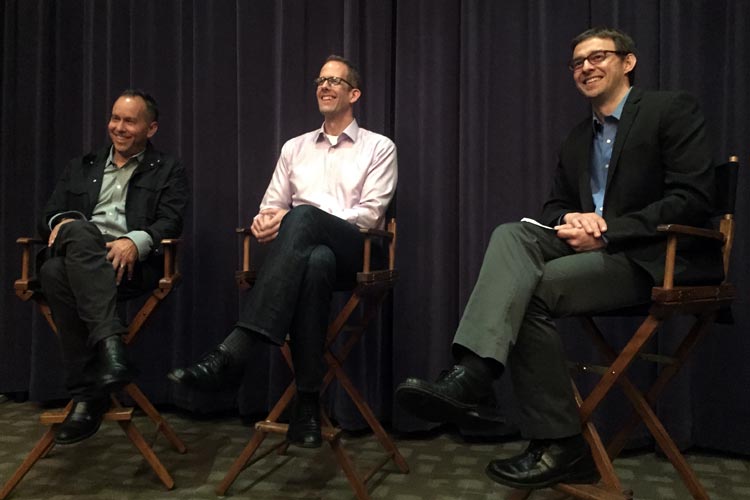The following questions and answers are excerpted from a conversation that followed the NBR screening of Inside Out.
How did you develop the visual language of this film?
Docter: It was really challenging. There were things that we felt were important early on that ended up boxing us in. Even having primary colors for all the emotions was difficult. I’m not saying this is easy, but with Nemo or Cars, you at least had a picture you could use – a fish or a car. But with this film, you can’t take a picture of an emotion. We relied on some verbal idioms like I feel blue, I feel sad, I’m about to explode with rage, etc. We would use those to start and the artists drew thousands of drawings.
“We wanted them to look like how our emotions feel.”
Rivera: There are so many variables on what Joy could look like. I think it was Albert Lozano, our character art director, who was able to put forth what Pete suggested, that we wanted them to look like how our emotions feel. They came up with this very simple thing. Joy was a star, or a spark. Golden and illuminated. Sadness was a teardrop. So her shape and color resemble a teardrop. Fear is like a raw nerve, just a squiggly line, that’s why he’s tight. Disgust is the shape and color of a stalk of broccoli. And of course anger is a brick, immovable. So we put those shapes on the wall and that was the foothold and now let’s personify that. It just felt right to us. We didn’t want them to be little people. Pete said they should be made out of energy.
Where did this story come from?
Docter: When my daughter was eleven, she kind of went from being a happy, spunky little spitball of a kid to being . . . kind of quiet. So I was like, oh no! I remember that and this is a hard time. She was already tall and lanky, and then there was this mood change that made me wonder what was going on inside her head. At the same time I was playing with ideas of emotions as characters, which seemed perfect for what animation could do. Strong, opinionated characters that make animation fun.
Rivera: He gave a great, really simple pitch. He said “What if we told a story about a little girl, but instead of her being the main character, she’s the set. And we go inside and personify her emotions and it’s told through that.” It seemed like such a worthy setup.
Did it change much from original pitch?
Docter: The original pitch was just, “here’s a concept.” Then we had to come up with an actual story and how to represent that dramatically with characters that grow and change. There were some definite side roads we took along the way. For Riley as a character, we wanted to talk about growing up and how best to represent that. You can’t have ticks on a doorway; you want to show it dramatically. So we ended up with moving as a metaphor. We started telling the story of a kid growing up, and then we realized we were actually telling a story of adults watching our kids grow up. Joy, as the main character, was originally paired with fear. For a lot of us, fear was a big motivating factor in junior high. We thought there would be a lot of entertainment possibilities. And there were, but three years in we started to realize that it wasn’t adding up to anything as a thesis statement. What was it about? So we stepped back. It kind of came to me when I realized the people I’ve been the closest with are the ones that I’ve gotten angry with, or shared loss with, and been scared for. It’s really those emotional moments that bring closeness with relationships, which are the most important things in our lives. That’s what made me go, “Okay fear has to go, and it’s about sadness bringing people together”. That was on a Sunday, Father’s Day . . .
Rivera: It was 10:30 at night and he calls, and we had a screening scheduled in three weeks, which is like five minutes in animation time. So we sat down with [co-director] Ronnie Del Carmen and Pete pitched this alternate version and we realized immediately it was the right way to go. It lead to a more beautiful ending and honored the original premise in a better way.
How do you balance making a film that works for both kids and adults?
Rivera: The movies we loved growing up have aged with us. I see Dumbo very differently now than I did when I was eight. Joe Grant was the head of story and hired by Disney in the 30s, and he was a mentor to Pete and by proxy I got to know him. He was this amazing guy, literally died drawing at his desk, we dedicated Up to him. He talked a lot about going beyond entertainment value and fun. He’d say things like “What are you asking the audience to take home with them when they leave the theater?” We feel so lucky we have these jobs where we get to make stuff and we try to make it personal. I think audiences do crave something with a nugget of truth, even in a fantastical film. Halfway through we started to wonder if it was getting too far out, but at a certain point you decide, we don’t care, we like it and we believe in it and it’s about our daughters. So we think that’s worthy and we’re going to make it as fun and as entertaining as possible.
Docter: And then add pie-in-the face and fart jokes.

